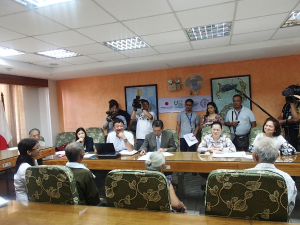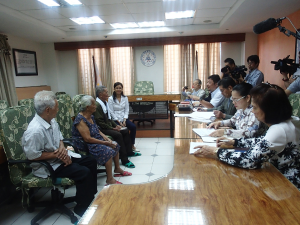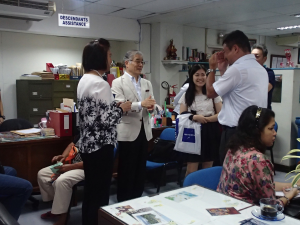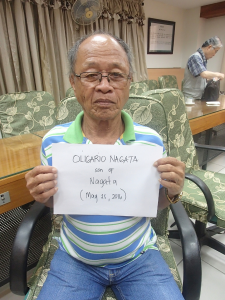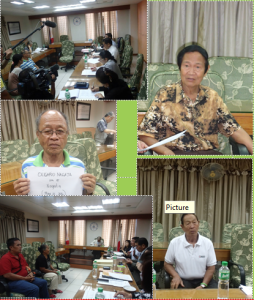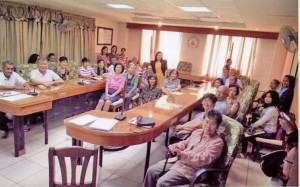MOFA INTERVIEW
The meeting in 2015 in Japan of the group composed of Mrs. Ines P. Mallari, Rengokai President, Mr. Carlos Teraoka , the former FNJK President, Mr. Benedicto Onari, the former President of the Cebu Nippi, Mr. Lemuel Yoshimura, a 2nd generation descendant but has not yet been recognized, Mrs. Estellita Roales of the Cotabato Nikkei and Ret. Judge Antonina B. Escovilla of the PNJK, Inc. Davao City with the high ranking official of the Nippon Foundation, Mr. Yohei Sasakawa, its chairman yielded positive result. Chairman Sasakawa facilitated the meeting of the group with the Prime Minister of Japan Hon.Shinzo Abe including different officials of the House of the Representative.
After meeting the officials named above, on May 23, 24, and 25, 2016, the unrecognized descendants were fortunate to have met in person here in Davao City, the Hon. Consul Susumu Tsuda, Counsellor and First Consul of the Embassy of Japan, based in Manila, Mr. Tadashi Miyazaki of the Nippon Foundation, Ikuko Okubo the Project Coordinator of International Affairs of Nippon Foundation and Mr. Norihiro Inomata, Director General of PNLSC of Japan.
The first to be interviewed that was held at the Board Room of PNJK, Inc. were Pacita Maramoto Torres, Roque Go Maramoto and Estodi Go Maramoto
Their father’s name is Maramoto Mashimura who worked as a carpenter. Most of the time he was engaged to work in the construction of houses as well as in the making of furniture. His Japanese friends were Shiroma Joho, Habuchi, Tsukagawa, Kimura, Tatsukama, Kusajima who worked either as farmer or fisher. They likewise married Filipino women in Manobo tribal marriage. Maramoto Mashimura married their mother Go Tomibay and had five children, two however died during their childhood. In 1940 while doing carpentry work in a house he fell causing injuries that made him bedridden. He passed away and was buried in the mountains of Colaman, Jose Abad Santos. With the outbreak of the war, all Japanese were nowhere to be found.
The next descendant who was interviewed was Inocencia Arakaki Aglang, 71 years old, and a resident of St. Cruz, Davao del Sur. Her Japanese name is Arakaki Yoneko. She does not have full recollection about her father. What she got from her mother were bits of data that are not helpful to her case as a child of a Japanese national. She does not know the date of birth of her father. Her father is an Okinawan named Hiroshi Arakaki and allegedly was killed by the guerilla. The father was an abaca farmer. Some of her father’s Japanese friends were Watanabe, Uechi, Kamashiki and Onaga.
Melanio Austero Takumi was called to narrate what he knew about his father whom he learned to be a carpenter as an occupation and had worked in an abaca plantation. It was in the year 1939 that his parents married by way of tribal rite. The house where most of their important documents were kept was burned thus he has no concrete evidence to support his claim of being the son of a Japanese. He believed that he is a son of a Japanese.
All records related to his personal circumstances have been changed to conform to his contention of being the son of Takumi san.
The turn of Lemuel Yoshimura came. He is a retired District Supervisor of the Department of Education in Koronadal, South Cotabato. Despite his retirement he is still clamoring for recognition as this is the only legacy he could leave to the next generation and is desirous of dying as a Japanese national. His father’s name is Yoshimura Masaharu. He managed a restaurant called “Fuji Shoukadou” in Estancia, Iloilo. The marriage of his parents took place in 1938 at Antique and three children were born out of that relationship. After the war their father left for Japan, leaving behind his family. Considered fatherless after the war, they were forced to change their family name from Yoshimura to their mother’s maiden name because of the antagonistic behavior shown by Filipinos. The mother was a teacher and from her pay she was able to support her children with the help of Lemuel who sold nuts and cigarettes at the same time engaged in shoe shine task. At nine years of age, their mother passed away. The three children were adopted by different families. A brother who was single died in 1965. His other brother got married but died in 2009. Meanwhile, Lemuel followed the profession of his mother. He became a teacher and was promoted as principal and retired as District Supervisor.
Oligario Aguan Nagata came to know of his father as Nagata only. His father came to the Philippines with a brother. They worked in an abaca plantation in Calinan, Davao City. Nagata met the mother of Oligario and their marriage took place in a bagobo tribal rite. After the war the father left for Japan and Oligario would like to go with him but the mother refused to let him go.


